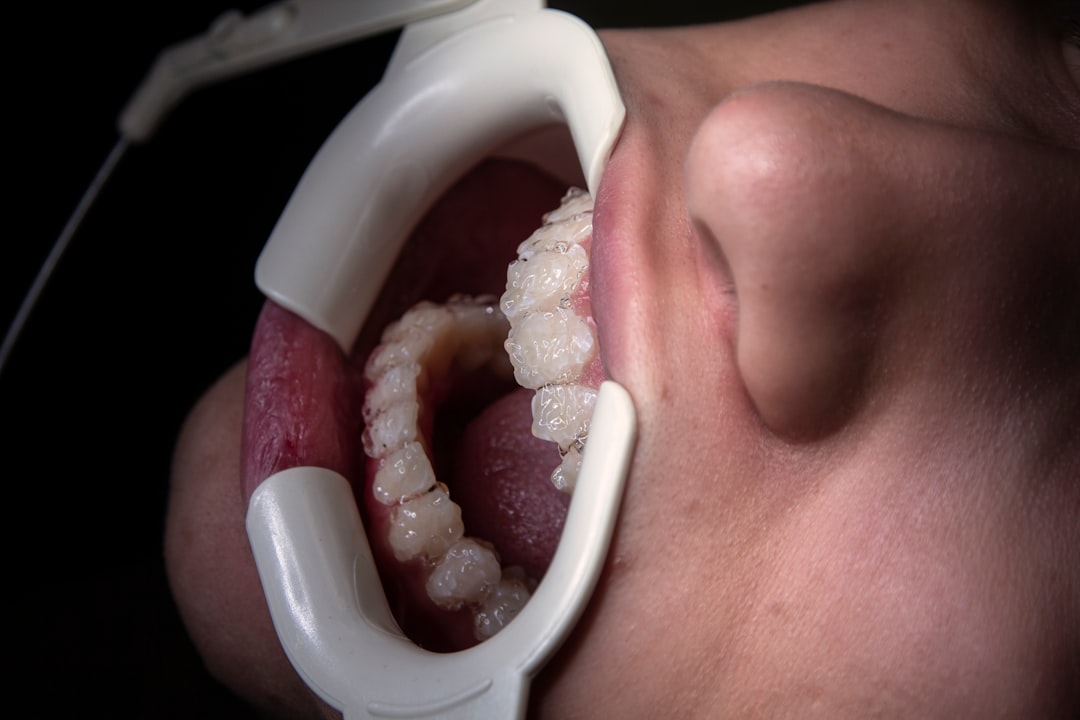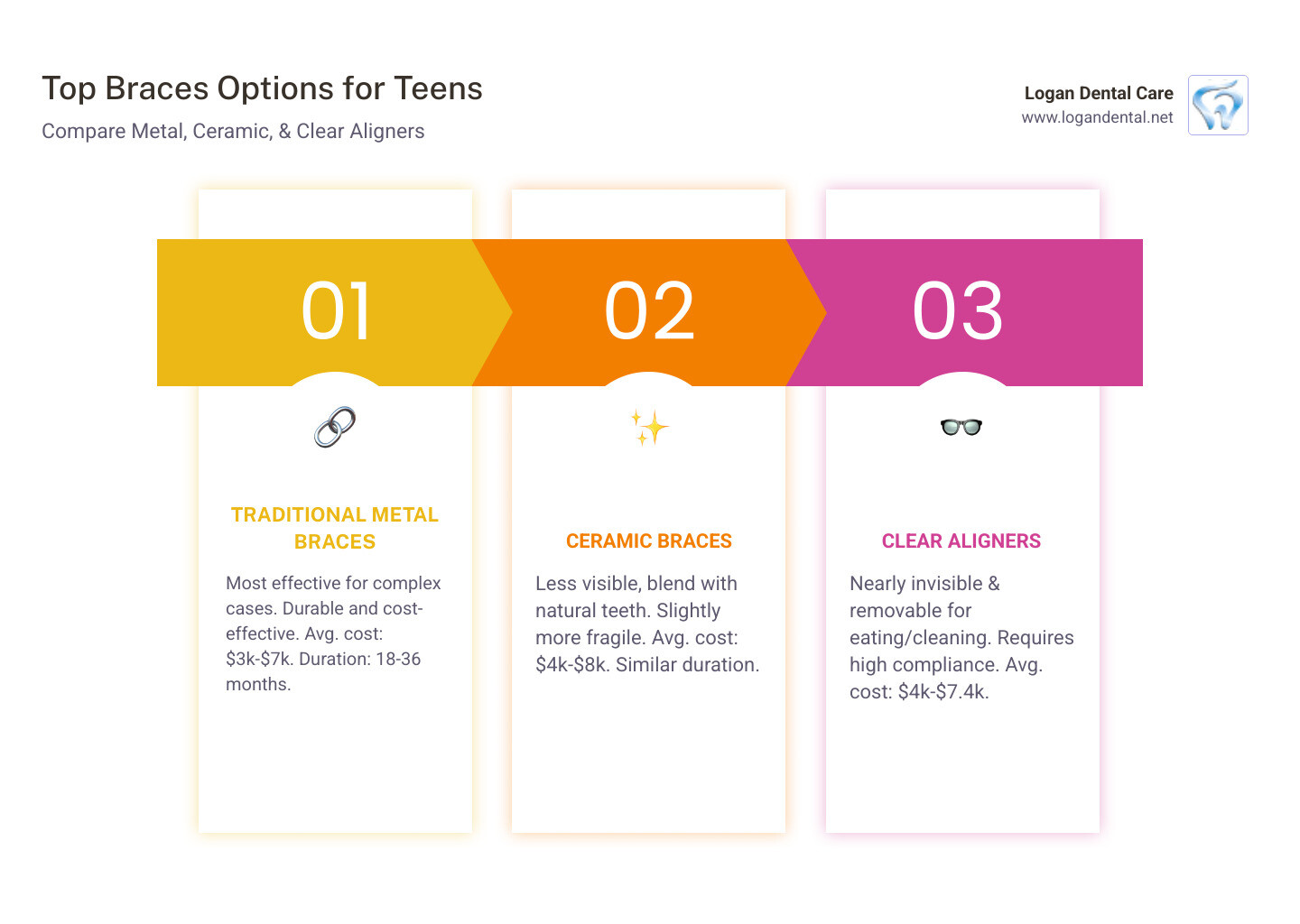Smile Confidently: Top Braces Choices for Teens

Why Braces for Teens Matter More Than Ever
Braces for teens are a modern rite of passage. The teenage years are the ideal time for orthodontic correction because bones are still malleable, making treatment more effective than in adulthood.
Top Teen Braces Options:
- Traditional Metal Braces - Most effective for complex cases, $3,000-$7,000
- Ceramic Braces - Less visible option, $4,000-$8,000
- Clear Aligners - Nearly invisible, removable, $4,000-$7,400
- Treatment Duration - Average 18-36 months depending on complexity
As one parent noted, the temporary self-consciousness from braces is minor compared to the lifelong insecurity of having crooked teeth.
The benefits go beyond aesthetics. Properly aligned teeth are easier to clean, which reduces the risk of cavities and gum disease, improves chewing, and can prevent future jaw problems.
The American Association of Orthodontists recommends an evaluation by age 7, with most treatments starting between ages 9-14. This timing leverages natural growth for more efficient results.
Today's braces are smaller, more comfortable, and work faster than ever. Treatments that once took years now average around 18 months with modern techniques.

Braces for teens terms you need:
A Comprehensive Guide to Braces for Teens
Choosing the right orthodontic treatment for your teenager can feel overwhelming. At Logan Dental Care in Bellefontaine, OH, we combine a small-town feel with the latest technology to guide your family. Today's braces for teens offer more options than ever, so let's explore what might work best for your child.
What Are the Different Types of Braces for Teens?
Traditional metal braces are a popular and effective choice. Today's versions are smaller and more comfortable, using stainless steel brackets and a wire to guide teeth. Their durability makes them ideal for complex cases. Teens can customize them with colorful elastic bands. As the most budget-friendly option, they typically cost between $3,000 and $7,000.
Ceramic braces work like metal braces but use clear or tooth-colored brackets for a more discreet look. They are more delicate and can stain, so extra care is needed with certain foods and drinks. Treatment may take slightly longer and costs range from $4,000 to $8,000.
Clear aligners like Invisalign are nearly invisible, removable plastic trays that are replaced every one to two weeks. They allow for easy eating and cleaning with no food restrictions. However, success requires discipline, as they must be worn for at least 22 hours a day. The cost is typically $4,000 to $7,400.
Lingual braces are another option, though less common for teens. They are attached to the inside of the teeth, making them completely invisible. They are the most expensive choice ($8,000 to $10,000) and can temporarily affect speech.
We'll help you determine which type of braces for teens makes the most sense for your child's needs. For more details, see our guide on different types of braces.
Understanding the Cost and Duration of Treatment
We know that braces for teens are a significant investment. The average cost is $3,000 to $7,000, but the final price depends on factors like treatment complexity and the type of braces chosen.
Most dental insurance plans offer some orthodontic coverage for children, typically $1,000 to $2,000. We work with your provider to maximize your benefits.
To make treatment affordable, Logan Dental Care offers flexible payment plans and financing. You can also use Health Savings Accounts (HSAs) or Flexible Spending Accounts (FSAs) to pay with pre-tax dollars.
Treatment time typically ranges from 18 to 36 months. Patient compliance is key to staying on schedule. Teens are often ideal candidates because their malleable bones and natural growth can lead to more efficient treatment and shorter timelines compared to adults.
For more information, visit our article on orthodontic treatment cost.
Daily Life: Oral Hygiene and Lifestyle with Braces
Life with braces for teens requires a few adjustments, but establishing good habits is key.
Excellent oral hygiene is crucial. Food and plaque can get trapped, so your teen should brush after every meal, paying special attention around brackets. Flossing is more challenging, but tools like floss threaders or water flossers make it much easier.
To protect the braces, your teen should avoid hard foods (nuts, ice) and sticky foods (caramel, taffy) that can cause damage. Many foods are still fine with simple modifications, like cutting apples into slices.
Teens can still play sports with braces. A custom-fit mouthguard is essential to protect their teeth and appliances during any contact sports.
It's normal to feel some soreness after adjustments. This can be managed with soft foods, over-the-counter pain relievers, and orthodontic wax to cover any irritating brackets.
For more tips, the American Dental Association offers helpful guidance on wearing braces.
The Orthodontic Process from Start to Finish
Getting braces for teens is a planned journey toward a healthier, more confident smile. At Logan Dental Care, we guide families with our blend of small-town warmth and advanced technology, ensuring you understand every step.
When Is the Ideal Time for a Teen to Get Braces?
The timing of orthodontic treatment can significantly impact its effectiveness and duration.
The Power of Early Evaluation:The American Association of Orthodontists recommends a child's first orthodontic check-up by age 7. This early visit isn't about getting braces right away; it's about assessment. It allows us to identify potential issues with jaw growth or emerging teeth early, which can prevent more complex problems later.
The Sweet Spot: Ages 9-14The ideal time for most teens to get braces for teens is between ages 9 and 14. During this period, their jaw is still growing and the bones are more malleable. This allows us to use their natural growth to guide teeth and jaws into the correct position more efficiently. By this age, most permanent teeth are in, giving us a clear picture for comprehensive treatment.
Treating during this optimal window often results in shorter treatment times and may help avoid more invasive procedures. Since every teen is different, a personal evaluation is key to determining the perfect start time.
For more detailed guidance, check out our guide on More info on Pediatric Orthodontics: When to Start.
How Do Braces Straighten Teeth and Correct Bites?
The science behind how braces for teens work is a blend of physics and biology.
The Dynamic Duo: Brackets and ArchwiresBraces work using two key components: brackets and archwires. Brackets are small handles bonded to each tooth. The archwire is a thin metal wire that runs through the brackets. It's shaped to the ideal arch, and as it tries to return to that shape, it applies gentle, constant pressure on the teeth, guiding them into alignment.
The Amazing Process of Bone RemodelingThis pressure triggers a natural process called bone remodeling. On the side the tooth is moving toward, special cells break down bone to clear a path. On the other side, different cells build new bone to fill in the gap. This slow, steady cycle allows teeth to move safely through the jawbone.
Tackling Complex Bite IssuesFor more complex issues, we may use additional tools. Elastic bands are often used to correct bite problems like overbites or underbites by connecting the upper and lower jaws. A palatal expander may be used to widen a narrow upper jaw, creating more space for crowded teeth.
Braces effectively treat a wide range of issues, including crowding, gaps between teeth, crossbites, and open bites. The treatment plan is customized for each patient's needs.
For a deeper understanding, explore our guide on More info on Orthodontic Treatment Explained.
What to Expect After Braces for Teens are Removed
The day braces for teens come off is exciting, but it's the start of the retention phase, which is crucial for maintaining the new smile.
The Moment You've Been Waiting ForThe removal process involves taking off each bracket and cleaning all adhesive from the teeth. We will also take final records to document the amazing result.
Why Retainers Are Your Teen's New Best FriendTeeth have a natural tendency to shift back to their original positions. Retainers are essential to hold teeth in their new alignment while the surrounding bone and ligaments stabilize. This retention phase is critical to protect your investment.
Choosing the Right RetainerThere are several types of retainers:
- Removable Retainers: These include traditional Hawley retainers (wire and acrylic) and clear plastic retainers that fit over the teeth like aligners.
- Fixed Retainers: This is a thin wire bonded permanently to the back of the front teeth, offering 24/7 retention.
The Lifetime CommitmentWe follow the motto: "Nighttime for a lifetime!" After an initial period of full-time wear, your teen will likely transition to wearing their retainer only at night. This simple habit is the key to preserving their beautiful smile for life.
Our Personalized AftercareOur care doesn't end when the braces come off. We provide detailed instructions for retainer use and care, schedule follow-up appointments, and are always here to support your family in maintaining that hard-earned smile.
Ready to learn more? Visit our page on Learn more about our Orthodontics Services to see how we can help your teen.



